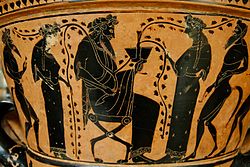Thiasus

InGreek mythology[1]andreligion,thethiasus(Greek:θίασος,romanized:thíasos) was the ecstaticretinueofDionysus,often pictured as inebriated revelers. Many of the myths of Dionysus are connected with his arrival in the form of a procession. The grandest such version was his triumphant return from "India",which influenced symbolic conceptions of theRoman triumphand was narrated in rapturous detail inNonnus'sDionysiaca.In this procession, Dionysus rides achariot,often drawn bybig catssuch astigers,leopards,orlions,or alternativelyelephantsorcentaurs.[2][3]
Thethiasosof the sea godPoseidonis depicted as a triumphal wedding procession withAmphitrite,attended by figures such as seanymphsandhippocamps.Inhistorical Greek society,thiasoi(pl.:Greek:θίασοι) werereligious organizationswhose existence was protected bylaw.[4]
Dionysianthiasos
[edit]
The most significant members of thethiasuswere the human female devotees, themaenads,who gradually replaced immortalnymphs.InGreek vase-paintingsorbas-reliefs,lone female figures can be recognized as belonging to thethiasusby their brandishing thethyrsos,the distinctive staff or rod of the devotee.
Other regulars of the retinue were various nature spirits, including thesileni(or human dancers costumed as such),phallusesmuch in evidence,satyrs,andPan.Theithyphallicsileni are often shown dancing on vase paintings.[5]The tutor of Dionysus is represented by a single aged Silenus. The retinue is sometimes shown being brought before a seated recipient: the tragic human welcomer of thegift of wine,IkariosorSemachos,and his daughter,Erigone.[6]In the triumphal form of procession,Ariadnesometimes rides with Dionysus as his consort.Heraclesfollowed the thiasus for a short while following his loss of a drinking contest to Dionysus.
On the 6th-century BCFrançois Vase,Dionysus is accompanied in procession by the threeHorae.[7]Other notable depictions in art include the silver "Great Dish" from theMildenhall Treasure,theLycurgus Cup,and in theRenaissanceTitian'sBacchus and Ariadne.The Dionysian retinue was a popular subject forRoman art,especiallybas-reliefsandsarcophaguspanels.
Marinethiasos
[edit]
A marinethiasos(or seathiasos) is a term for a group like the Dionysian thiasos, except with the chief god replaced byPoseidonor some othersea deity.[8][9]Lattimore while insisting that the chief god must be Poseidon in a strict sense, includes examples where Poseidon is completely absent in the composition, which most frequently figureTritonsandNereidsas marine retinues.[8]
An original work ofScopason this theme was taken to Rome and described byPliny,but is now lost.[10][9]Still, the theme is well represented in surviving works of Roman art, from tiny decorative reliefs and largesarcophaguspanels to extensive mosaics.
Even in the Skopas example, the main theme was the deliverance of the slainAchillestoElysium,attended by his motherThetis(though Poseidon is present as well),[9]and examples of Thetis's retinue have been described as marinethiasos.[11]
The marinethiasoscould otherwise be the retinue forOceanus,[12]or to Venus Marina.[13]
Notes
[edit]- ^Karl Kerenyi,Dionysos: Archetypal image of indestructible life1976:123, observes that "the ecstatic band ofbacchantesand agitated male nature gods in a state of heightenedzoë... is not reflected inMinoan art."
- ^Motto Anna Lydia; Clark, John R.; Byrne, Shannon N.; Cueva, Edmund P. (January 1999).Veritatis Amicitiaeque Causa: Essays in Honor of Anna Lydia Motto and John R. Clark.Bolchazy-Carducci Publishers. p. 249.ISBN9780865164543.
{{cite book}}:CS1 maint: multiple names: authors list (link) - ^Kondoleon, Christine (1994).Domestic and Divine: Roman Mosaics in the House of Dionysos.Cornell University Press. p. 194.ISBN9780801430589.
- ^For example thethiasosin Athens examined by Marcus N. Tod, "A Statute of an Attic Thiasos",The Annual of the British School at Athens13(1906/07):328-338).
- ^Karl Kerenyi (Dionysos: Archetypal image of indestructible life1976), selects as an example a 6th-century vase, figs 39/A and B.
- ^See Kerenyi 1976, ch. iv. "The Myths of Arrival".
- ^Detail illustrated in Kerenyi 1976 fig. 37.
- ^abLattimore, Steven (1976).The Marine Thiasos in Greek Sculpture.Institute of Archaeology, University of California, Los Angeles. p. 1.ISBN9780917956027.
The term 'marine thiasos' might be defined.. most correctly [as] a marine group.. attending the marine god, Poseidon, however.. may not always be depicted.
- ^abcPapagiannaki, Anthousa (2014).Nereids and Hippocamps: The Marine Thiasos on Late Antique and Medieval Byzantine Ivory and Bone Caskets.Cambridge Scholars Publishing. pp. 73–74.ISBN978-1-443-86774-0.
{{cite book}}:|work=ignored (help) - ^Lattimore (1976),pp. 13–
- ^South, Alison K. (1982),"Excavations at Kalavassos-Ayios Dhimitrios",Annual Report of the Director of the Department of Antiquities,Republic of Cyprus: 369
- ^Toynbee, Jocelyn M. C. (1964).Art in Britain under the Romans.Clarendon Press. p. 309.ISBN978-0-19-817143-0.,also quoted by Hutchinson, Valérie J. (1986),Bacchus in Roman Britain: the evidence for his cult,p. 286.
- ^Stirling, Lea Margaret(1994).Mythological statuary in late antiquity: a case study of villa decoration in southwest Gaul.University of Michigan. p. 109, n11.ISBN978-1-443-86774-0.,citing Kaufmann-Heinimann (1984), pp.318–321.
